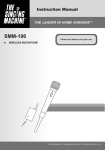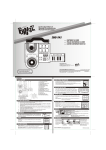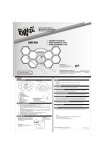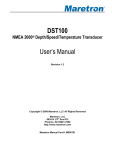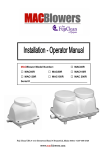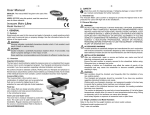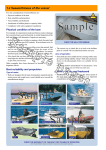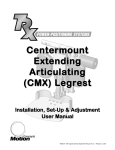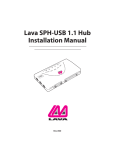Download DKT-5 Manual - SR Instruments, Inc.
Transcript
SR MARINER DIGITAL KNOTMETER INSTALLATION INSTRUCTIONS Congratulations in choosing a high performance marine instrument and welcome to the growing family of SR Mariner product owners. Since our establishment in 1973, we have engineered our products to give you quality at a reasonable price. To familiarize yourself with all the features and installation procedures please read the following instructions carefully. If you still have any questions or comments please call your nearest dealer or call us at (716) 693-5977 or write: SR Instruments 600 Young Street Tonawanda, NY 14150 Attn: Service Department It is recommended that you temporarily hook up your SR MARINER equipment before installation so you become familiar with its connections and system performance. DO NOT CUT ANY CABLES, but connect according to wiring diagram (fig.3). Spin the paddlewheel on the transducer to activate the knotmeter. If all functions perform satisfactorily, proceed with installation. If the system fails to perform, check all connections. If system still fails to perform check with your dealer for advice and or replacement if needed. CHARACTERISTICS OF DIGITAL KNOTMETER MODEL DKT-5 SCALE 0.0-19.99 INSTALLING THE DISPLAY 1. Cut a 4-1/16" (max 4-1/8") diameter hole in the bulkhead or instrument panel where the display unit is to be mounted (fig.1). 2. Be sure to remove all burrs and clean the face of the bulkhead or panel with detergent to remove all traces of dirt, oils, fingerprints, etc... 3. Each display unit is furnished with an adhesive backed sealing ring to hold the unit fast in place and creates a watertight seal. Please note that it is not recommended that the paper backing be removed until the system is tested and finally calibrated. When ready for final mounting simply remove the paper backing, position unit correctly and firmly press into place. 4. Install the RETAINING RING as shown and tighten with a blade type screwdriver. INSTALLATION TIPS SAILBOATS: The preferred position of the transmitter is where water is diverging around the hull and is free from turbulence and eddies. This is generally in the forward one-third of the hull in front of the keel and approximately one foot off the centerline. Generally the knotmeter transmitter can be mounted on one side of the keel with the depth transducer in a similar position on the opposite side of the keel. If due to access considerations, it is necessary to locate the depth transducer and the knotmeter transmitter on the same side on a fore and aft line, be sure to locate the depth transducer forward of the knotmeter transmitter so that the turbulence created by the paddlewheel does not interfere with the depth sensor. POWERBOATS: The depth transducer and knotmeter transmitter are generally located aft so that they remain immersed at full speed. Both sensors must remain forward of the propeller turbulence but remain sufficiently under water as not to encounter surface bubbles. INSTALLING THE TRANSMITTER 1. The thru-hull fitting requires a 2-1/8" hole with a 30-degree flange. This can be done by use of a hole saw and then filing the flange or by use of a tool (THT) provided by SR Instruments. If this tool is not available locally, contact the factory and arrangements can be made to rent one. NOTE: This tool requires a 1/2" drill motor. 2. When the THT tool begins to cut the flare, drill in stages, checking the fit of the thru-hull fitting so as not to cut too deep. Be sure the thru-hull fitting is flush with the hull. 3. With the edge of a file, cut or file a notch FACING FORWARD, to seat the key way of the thru hull fitting. 4. Apply bedding compound around the lip and body of the fitting where it will be in contact with the hull. 5. Insert the thru-hull fitting and tighten the FITTING NUT by using a spanner wrench or tap with a small wooden block against the nut to provide a snug fit. DO NOT OVER TIGHTEN! FOLLOW THE MOUNTING INSTRUCTIONS FOR DISPLAY AND TRANSMITTER BEFORE PROCEEDING: 1. Be sure that the thru-hull fitting is properly installed with the KEY WAY facing FORWARD before you insert the transmitter into the thru-hull fitting. This key way mates with the speed sensor to assure proper orientation when transmitter is removed for maintenance or replacement. NOTE: The thru-hull fitting should already have an o-ring installed. An extra o-ring is provided with the dummy plug. 2. Connect the transmitter and power wires to the display unit as shown in figure 3. 3. If you choose to connect night lighting simply connect your 12 volt D.C. wire as indicated in Figure 3, and install a SPST switch on the positive (+) line to complete the circuit and activate the lights. CALIBRATION 1. Your instrument is factory calibrated to read knots, however, if you need to recalibrate you must first remove the plug from the hole marked CAL (fig.3). 2. Proceed on a timed measure course to determine proper speed. 3. After making an initial determination of boat speed, turn the calibration adjustment CLOCKWISE to INCREASE the indicated speed or COUNTERCLOCKWISE to DECREASE. A small blade type screwdriver will serve the purpose. The same adjustment may be used to calibrate in either KNOTS or STATUTE MILES. NOTE: DO NOT APPLY EXCESSIVE PRESSURE TO THE CALIBRATION CONTROL! 4. The AVG. knob is a dampening control which can be adjusted to accommodate to water conditions. POWER CONSUMPTION LIGHTS OFF ON AMPS .007A .160A TROUBLESHOOTING DISPLAY IS BLANK- Check to be sure you have power to the display. If there is power going to the display then please send the unit for repair to the address on the front of the manual. HAVE DISPLAY; READS ZERO- The problem could be either the transmitter or the display. Please follow the proceeding steps to determine cause of the problemA. Measure the two wires of the transmitter with an ohm meter for resistance value of approximately 2000 ohms (2K ohms). Do not spin the paddlewheel. a. If unit is good, then check paddlewheel for any broken fins or missing magnets. b. If unit is open (infinite resistance) then unit needs replacing. B. Measure with an AC voltmeter when the paddlewheel is spinning. You should get approximately 1.0 VAC at about 5 knots of speed when unloaded (not hooked up to display). INTERMITTENT READINGS- Keep the unit wired as normal and add an AC voltmeter to where the input wires of the transmitter are connected. Motor or sail as usualA. If an AC voltage is being produced but no speed indication appears on display, then the problem is in the display. B. If readings only occur when voltages are produced, then the paddlewheel is not always turning. Clean paddlewheel first and be sure it spins freely, and then try again. If the results are the same then paddlewheel may need replacing. ACCESSORIES FRICW-1 FRO-RING FRDP-1 FRTR-1R FRCLP RNG FRMC-1 FRSEAL RING FRTH-1 INSTRUMENT COVER GASKET FOR THRU-HULL DUMMY PLUG IMPELLER AND PIN CLAMP RING METER CASE FOR DKT (YOUR MODEL NUMBER) GASKET FOR INSTRUMENT GAUGE THRU-HULL FITTING





